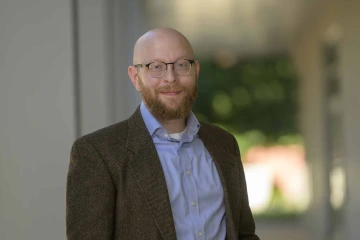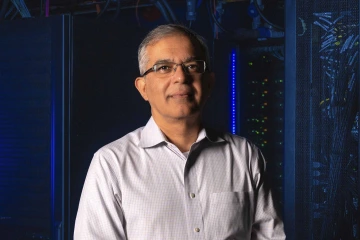Ready or not, AI is in your classroom
Faculty are experimenting with ways to include artificial intelligence in their curriculum and allowing students to use AI platforms in their work.

For Health Sciences faculty, artificial intelligence in the classroom has expanded beyond the use of plagiarism checkers to ChatGPT helping to write papers or even creating sample exam questions.
Photo by Kindamorphic via Getty Images
Artificial intelligence does have, and has had for a long time, a place in the classroom. Consider the use of applications like TurnItIn, which professors have used to detect plagiarism in coursework for a number of years.
While TurnItIn has been widely used, a recent study by the University of Arizona’s Hui Wang found that out of the top 100 universities in the U.S., more than a third had unclear policies on the use of artificial intelligence.
The Wall Street Journal reported that OpenAI has actually developed a way to detect plagiarism but hasn’t released it yet despite concerns that some students might use AI to cheat. The University Center for Assessment, Teaching & Technology is currently piloting ChatGPT as an integration platform for classroom activities.
Those applications can make reviewing essays and papers easier by eliminating the need for each classroom leader to check for copied work. But beyond that, Health Sciences educators are putting AI to good use for today’s students.
AI giving an assist on exams
At the University of Arizona R. Ken Coit College of Pharmacy, Christopher Edwards, PharmD, said he and Brian Erstad, PharmD, recently completed a study to see if AI can write useable exam questions for a hypothetical course.

Christopher Edwards, PharmD
Photo by Kris Hanning, U of A Health Sciences Office of Communications
“We gave ChatGPT a limited amount of information and ask it to produce 10 multiple-choice questions around a given topic,” he said. But there’s a catch.
“How usable are those questions right out of the box?” Edwards asked. “Do they accurately reflect the material? Is it asking you something that matters? Is it relevant? Is it the appropriate level for the class that you are assigning it to?
“We found about half of the questions were decent. They could be used right away with some minor revisions by the instructor so that those questions could probably be used on an exam or quiz.”
The potential time-saving quality of AI-generated questions makes it useful, he added, much like when spell-check first became readily available.
“When spell-check came out, there was a lot of discussion around how people aren’t going to learn how to spell because they’re just going to rely on this tool in order to help point them in the right direction,” he said. “And that’s not necessarily true, right? I think people have learned to incorporate spell-checking into their daily workflows and learned to ignore the spell-checker when it’s giving them bad information.
“We have to figure out where AI ethically fits into the current landscape. I don’t think the correct answer is, ‘Oh, this thing exists, but we should just ignore it and pretend that it isn’t there.’ It does have a lot of potential, particularly for procedurally generated writing.”
Data Science Institute working on keeping information safe
Nirav Merchant, director of the Data Science Institute and a member of the university’s AI Access & Integrity Working Group,said the group is building a unified platform that allows educators the ability to provide large language model access to their students with content guardrails, privacy preserving capabilities and with budget controls.

Nirav Merchant
Photo by Noelle Haro-Gomez, U of A Health Sciences Office of Communications
The goal, Merchant said, is to create a platform that educators can use to make teaching in modules easier, and allow students to experiment and build solutions using LLMs to solve real world challenges. At the same time they want to ensure that educators can introduce the students to LLMs that are discipline specific or have been tuned for special tasks.
“Availability of commercial and open LLMs has exploded and will continue to do so, and the performance is continuously improving” said Merchant, a member of the BIO5 Institute. “We wanted to ensure our educators can include cutting edge LLM capabilities without being burdened of figuring out how to provide access to these resources to a large classroom”
The platform AI VERDE (Virtual Explorer for Research, Discovery, and Education) completed its pilot phase in the fall. Faculty used different LLMs from commercial platforms like ChatGPT for teaching introductory R programming language to open and tasks specific like MedLLAMA. Overall the students and faculty had positive feedback, and are continuing to teach new workshops and topics.
With many new AI resources being made available through the National AI Research Infrastructure, the group wants to ensure AI VERDE can become the gateway for the university to readily consume those for novel teaching content and research Merchant said.
Using AI to create better educational experiences
Peggy Jenkins, PhD, RN, CNE, the associate dean for academic affairs at the U of A College of Nursing, said the college’s instructional designers have been looking at interactive modules for some of the prelicensure courses. “Now you have these interactive learning modalities that has really increased the success rate of students,” she said.

Brian Ahn, PhD
Photo by Kris Hanning, U of A Health Sciences Office of Communications
While the students at the college are very interested in including AI in their education, the college administration is also working to bring faculty along as well through the instructional design. “What they’ve also looked at is they’re really trying to create an acceptance of AI and move away from a punitive approach because sometimes that’s the first thing that faculty think about is, ‘How do we catch students who are using AI’ and we don’t want that to be our philosophy,” she added. “Our philosophy is ‘How do we embrace AI as a tool that will help with education?’”
Jenkins noted that every College of Nursing syllabi has an AI statement that lays out what the expectations are of that particular faculty member around AI use by the student. The individual instructor can specify from no AI use to unregulated use, but the faculty are urged to take a middle ground approach to its use.
Brian Ahn, PhD, dean of the college, said the use of AI in the curriculum of nurse practitioners can be extremely helpful. “For example, there are over 20 different blood pressure medications that can be prescribed,” he said. “Which to use depends on my knowledge, my experience and so on. But now with AI, there are several tools we can use. We enter the symptoms and social demographic profiles and it can suggest the specific medication with the rationale. We are teaching how we can utilize this AI tool, but we are also discussing whether it is correct or not.” The ultimate decision on whether or not to use the medication comes down to the nurse practitioner, not the AI.
ASTEC built around the idea of AI
Of course, the Arizona Simulation Technology and Education Center literally has education as part of its name and mission. Launched as part of the College of Medicine – Tucson in 2004, the center has gradually expanded in size and scope while also moving in 2016 under the U of A Health Sciences umbrella to carry out the mission of interprofessional education. ASTEC moved into its 35,000-square-foot space in the Health Sciences Innovation Building in 2019.

Allan Hamilton, MD
Photo by Kris Hanning, U of A Health Sciences Office of Communications
Students and researchers from across the Health Sciences and the university are able to learn and conduct research in the space. Allan Hamilton, MD, the executive director of ASTEC, said AI can be used to teach medical students how to be more empathetic when dealing with patients. In fact, he’s working on a “third stage” of AI that can tell how people are interacting with each other.
“Our medical students are very hungry for AI,” Hamilton said. “They want to engage it. They’re using it. They know how to use it. The faculty, on the other hand, want to be able to instruct them using it, but they’re not as facile with it.”
But using artificial intelligence to look for plagiarism has become an accepted part of modern education, he pointed out.
“I will tell you what: I would think right now it’d be stupid to assign somebody a 3,000-word essay on the Krebs cycle because they’ll get that essay done in 20 seconds using AI,” Hamilton said. “So, you, as an educator, can make up your mind that everybody’s going to go back to blue composition books and write out answers longhand, which seems a little silly. Or you can say, ‘I’m going to judge the level of understanding by the quality of the discussion that I have with you.’ I can ask AI to listen and say, ‘Tell me if you think that was good retention’ as a way to utilize the technology to determine whether the lesson was successful.”
Edwards said, “When it comes to AI utilization in the classroom, I think letting the creative minds flow is the way to go. I think there are some innovative things that people could be doing with AI in terms of teaching students how to use AI or how to design assessments. If you put too stifling of restrictions on the use of AI in the classroom, you could end up in a situation where you could potentially prevent some pretty cool things that I think are very future-facing, very, very forward-thinking.”
While stifling innovation is the last thing on anyone’s mind, there is no going back. As Hamilton said, the genie’s out of the bottle when it comes to AI.
Stay up to date on AI
Want to stay in the know on how artificial intelligence is or can be used in the classroom or research? There are many ways to engage with it at the university.
To learn more about the University of Arizona’s artificial intelligence resources and tools, a website outlining standards, usage and AI-related courses is available. The AI working group holds regular meetings on AI-related topics.
Read more:
Integrating AI into research may revolutionize outcomes
New AI coaching bot may enhance medical education, training
Leveraging AI to enhance future physician training
Paging Dr. Robot: Marvin Slepian on AI in health care
Would you trust an AI doctor? New research shows patients are split

